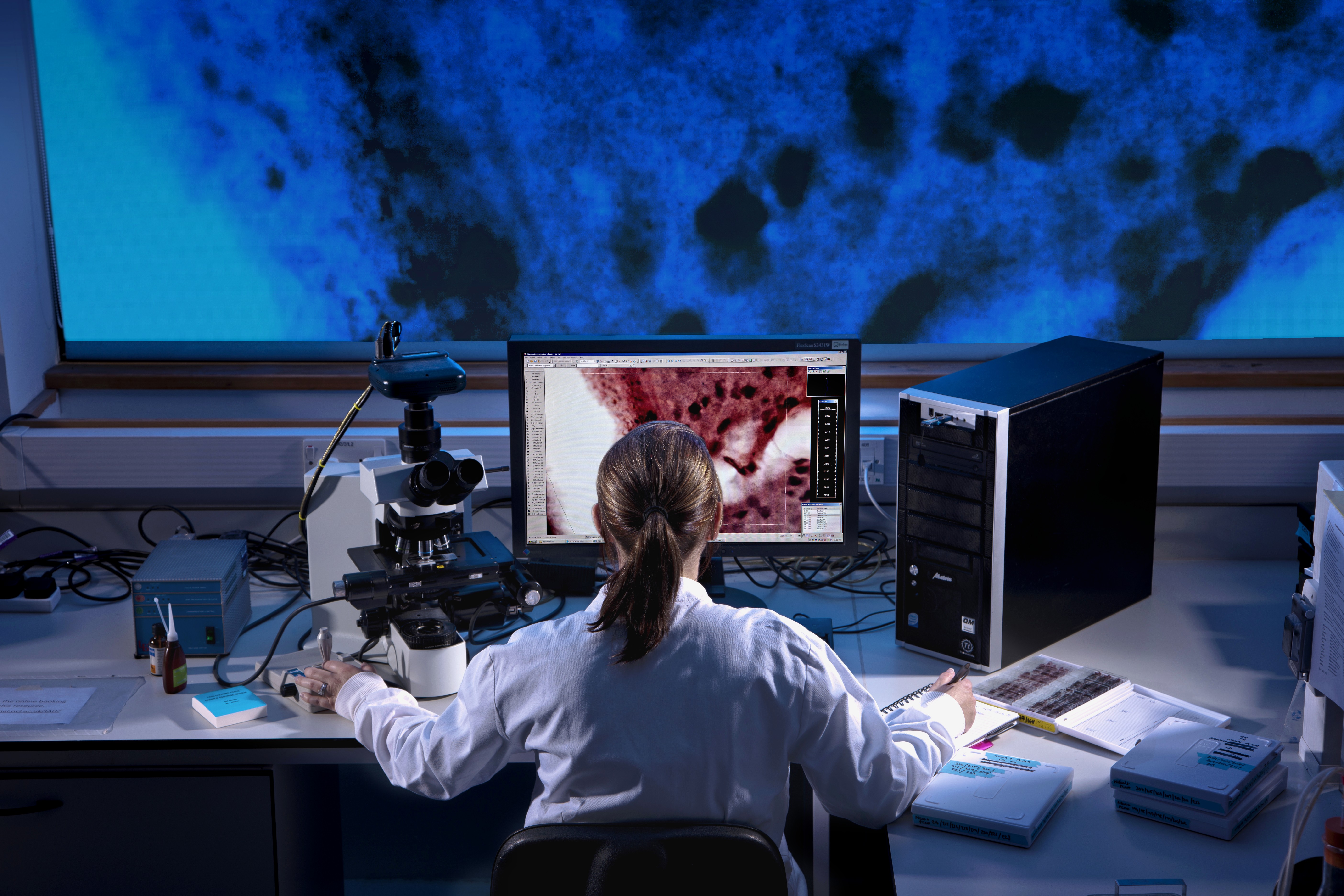How fetal tissue is used in medical research
Planned Parenthood has been heavily criticized for providing cell tissue from aborted fetuses to medical researchers

Planned Parenthood has been heavily criticized for providing cell tissue from aborted fetuses to medical researchers. Here, a quick look at the legitimacy of those claims:
How do scientists use fetal tissue?
It's used to find potential treatments for a wide range of common diseases and afflictions, including cancer, diabetes, birth defects, HIV, multiple sclerosis, ALS, and Alzheimer's. Unlike adult tissue cells, fetal tissue cells can be manipulated into almost any kind of tissue, are less likely to be rejected by a host, and have the capacity to replicate rapidly — making them perfect for analysis into how diseases work. They are also being tried as actual treatments for Parkinson's disease, spinal cord injuries, and diabetes, with researchers injecting fetal cells directly into organs in hopes of regenerating them. Fetal tissue was also a vital component in the development of vaccines for polio, chicken pox, rubella, and shingles. The polio vaccine alone saves 550,000 lives a year. Alta Charo, a bioethicist at the University of Wisconsin at Madison, says fetal tissue research has benefited "virtually every person in this country."
The Week
Escape your echo chamber. Get the facts behind the news, plus analysis from multiple perspectives.

Sign up for The Week's Free Newsletters
From our morning news briefing to a weekly Good News Newsletter, get the best of The Week delivered directly to your inbox.
From our morning news briefing to a weekly Good News Newsletter, get the best of The Week delivered directly to your inbox.
How long has this research been conducted?
Since the 1930s. To develop the polio vaccine, scientists infected fetal kidney cells with the virus in Petri dishes, then used the weakened virus in those cells to teach the immune system how to repel the virus — a development that earned its creators the 1954 Nobel Prize in medicine. In 1968, the donation of tissue from aborted fetuses was formally legalized. President Ronald Reagan imposed a five-year moratorium on such research, but in 1993, President Bill Clinton and Congress again authorized the practice. The law imposed several conditions: Abortion providers cannot profit from the distribution of fetal tissue; donors must give their signed consent, which can be sought only after they have agreed to the abortion itself; and abortion methods cannot be altered to make it easier to extract tissue. The National Institutes of Health spends about $76 million of federal funds on fetal tissue research each year.
Why has this become an issue?
Because of a series of undercover "sting" videos released by the Center for Medical Progress, a pro-life group. These videos show officials from the women's health group Planned Parenthood blithely discussing reimbursement costs for the storage and transport of fetal tissue, and graphically describing how doctors performing abortions try to ensure that fetal organs remain whole. "We've been very good at getting heart, lung, liver," one official was recorded saying, over a glass of wine and a salad. "I'm gonna basically crush below [the organ], I'm gonna crush above, and I'm gonna see if I can get it all intact." Since the release of the videos, Republican lawmakers have been trying to strip Planned Parenthood of its federal funding.
A free daily email with the biggest news stories of the day – and the best features from TheWeek.com
Were any laws broken?
If Planned Parenthood changed abortion practices to get specific fetal organs, it might be a violation of the 1993 federal law. Planned Parenthood denies that it did so, saying the "comments of one employee" do not reflect the organization's practices. The organization also says it did not profit from the transfer of fetal tissue to researchers, and that it charges only $30 to $100 for transportation. The tissue-donation program exists in only six of its 700 clinics, in California and Washington state. (To counter charges that it's selling tissue, Planned Parenthood has announced it will henceforth absorb those costs itself.) Defenders of the fetal tissue donation system argue that if the tissue from legal abortions were not used for lifesaving research, it would simply be discarded. Critics say positive outcomes cannot justify a practice that is itself immoral. "You're basically taking the life of one member of human society to use for the life of another," says Kathleen Schmainda, a professor at the Medical College of Wisconsin. "It corrupts the science."
Are there any alternatives?
Yes, though imperfect ones. Cells from umbilical cord blood have been used in some studies. Fetal tissue can be extracted from miscarriages — but there's far too little of such tissue to supply scientific demand. More promising are the recent advances in stem cell technology, which allow adult cells to be reprogrammed into "blank check" cells. Most scientists accept that this process, which is already being used in some studies, could eventually phase out the need for fetal tissue collection altogether. But stem cell technology is still new, and for the time being, scientists working on treatments for dreaded diseases contend that fetal tissue remains vital to their research.
Will fetal research continue?
For now, although congressional Republicans are investigating and want it stopped. In response to the furor over the Planned Parenthood videos, several universities have suspended the acquisition of fetal tissue. Ultimately, the debate over fetal tissue has become inextricably linked with the ever-divisive question of abortion. Pro-lifers believe doing anything with an aborted fetus is morally wrong, because abortion itself is wrong; pro-choicers say that since abortion is both legal and inevitable, why not use discarded fetal tissue for research that may relieve the suffering of millions of people? As Tom Beauchamp, a professor of philosophy at Georgetown University, puts it: "You can't make this fundamental clash of perspectives go away."
The real tissue traders
Planned Parenthood isn't making any money from the sale of fetal tissue, but other organizations certainly are. Many laboratories rely on middlemen who pay abortion providers small fees — usually $100 or less — for specimens, extract from the specimens whichever cells are in demand, and then deliver those cells to researchers. While the firms cannot legally profit from selling the tissue itself, they can charge whatever they like for processing and preparing it. A small vial of fetal liver cells, for example, can fetch more than $24,000. The companies argue these prices merely reflect the cost of isolating the cells. "These are hard processes, expensive processes," says Cate Dyer, founder of the for-profit StemExpress. "Just to attempt to do some of these isolations can cost us thousands of dollars, and it may not even work." But critics see the reimbursement policy as a gaping loophole — one that could easily be closed. "What's going on now is probably legal, but Congress won't like it," says Boston University bioethicist George Annas. "The law can easily be changed."
-
 Best poetry books of 2025
Best poetry books of 2025The Week Recommends Magnificent collections from Luke Kennard, Leo Boix and Isabelle Baafi
-
 11 extra-special holiday gifts for everyone on your list
11 extra-special holiday gifts for everyone on your listThe Week Recommends Jingle their bells with the right present
-
 ‘Furious Minds: The Making of the MAGA New Right’ by Laura K. Field and ‘The Dream Factory: London’s First Playhouse and the Making of William Shakespeare’ by Daniel Swift
‘Furious Minds: The Making of the MAGA New Right’ by Laura K. Field and ‘The Dream Factory: London’s First Playhouse and the Making of William Shakespeare’ by Daniel SwiftFeature An insider’s POV on the GOP and the untold story of Shakespeare’s first theater
-
 Has Zohran Mamdani shown the Democrats how to win again?
Has Zohran Mamdani shown the Democrats how to win again?Today’s Big Question New York City mayoral election touted as victory for left-wing populists but moderate centrist wins elsewhere present more complex path for Democratic Party
-
 Millions turn out for anti-Trump ‘No Kings’ rallies
Millions turn out for anti-Trump ‘No Kings’ ralliesSpeed Read An estimated 7 million people participated, 2 million more than at the first ‘No Kings’ protest in June
-
 Ghislaine Maxwell: angling for a Trump pardon
Ghislaine Maxwell: angling for a Trump pardonTalking Point Convicted sex trafficker's testimony could shed new light on president's links to Jeffrey Epstein
-
 The last words and final moments of 40 presidents
The last words and final moments of 40 presidentsThe Explainer Some are eloquent quotes worthy of the holders of the highest office in the nation, and others... aren't
-
 The JFK files: the truth at last?
The JFK files: the truth at last?In The Spotlight More than 64,000 previously classified documents relating the 1963 assassination of John F. Kennedy have been released by the Trump administration
-
 'Seriously, not literally': how should the world take Donald Trump?
'Seriously, not literally': how should the world take Donald Trump?Today's big question White House rhetoric and reality look likely to become increasingly blurred
-
 Will Trump's 'madman' strategy pay off?
Will Trump's 'madman' strategy pay off?Today's Big Question Incoming US president likes to seem unpredictable but, this time round, world leaders could be wise to his playbook
-
 Democrats vs. Republicans: who are US billionaires backing?
Democrats vs. Republicans: who are US billionaires backing?The Explainer Younger tech titans join 'boys' club throwing money and support' behind President Trump, while older plutocrats quietly rebuke new administration